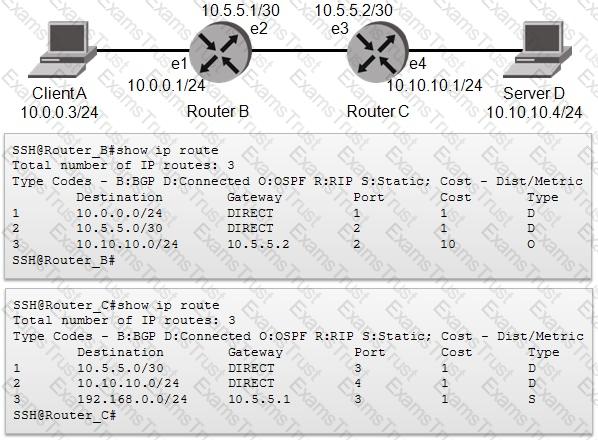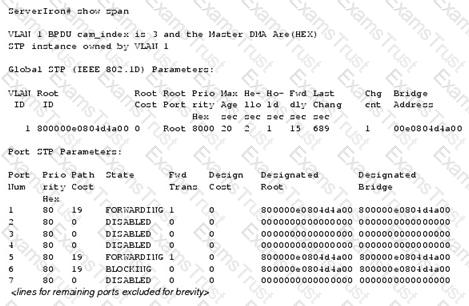What are two Brocade stackable products? (Choose two.)
Which two features are implemented using Brocade IronStack technology? (Choose two.)
Optical monitoring is not returning data. What are three reasons for this happening? (Choose three.)
An identical route has been discovered by OSPF and RIP. By default, the OSPF route is chosen and added to the routing table. What should be done to allow the RIP route to be preferred?
What are two supported stacking topologies for the Brocade IronStack technology? (Choose two.)
What are three types of private VLANs supported on a Brocade FastIron? (Choose three.)
Which type of message is exchanged between switches to prevent loops and maintain loop-free topologies?
The traffic volume received by your network clients is higher than desired.
Which two features will help reduce the amount of unwanted traffic? (Choose two,)
Referring to the exhibit, requests from Client A are being seen on Server D but responses are not making it back to Client A.

What are two methods that will resolve the issue? (Choose two.)
What are the three available QoS scheduling algorithms available on Brocade NetIron and FastIron products? (Choose three.)
You have to implement a security protocol that encrypts all traffic between the Brocade device and the authentication server.
Which security protocol would you use to support this requirement?
In the exhibit,

Which port is responding to a change in the network topology?
What are the two ways that IGMP is used? (Choose two.)
Which two statements about ingress extended ACLs are correct? (Choose two.)
You have configured your Brocade device as shown in the exhibit.
Brocade#sh ip
Switch IP address: 10.200.128.116
Subnet mask: 255.255.255.0
Default router address: 10.200.128.1
TFTP server address: 10.200.46.57
Configuration filename: Brocade
Image filename: None
IP MTU: 1500
Brocade#traceroute 10.200.128.1
Type Control-c to abort
Tracing the route to IP node 10.200.128.1 from 1 to 30 hops
1 <1 ms <1 ms <1 ms 10.200.128.1
Which statement is correct regarding interface Ethernet 10 on this device having inbound traffic from 172.17.1.1/24 to 172.17.2.1/24 on port 21?
What are two ways that TACACS+ differs from TACACS? (Choose two.)